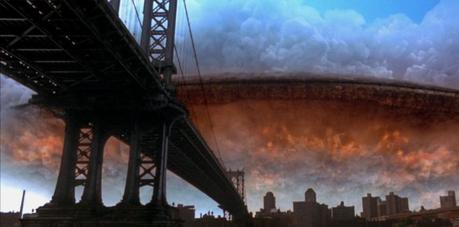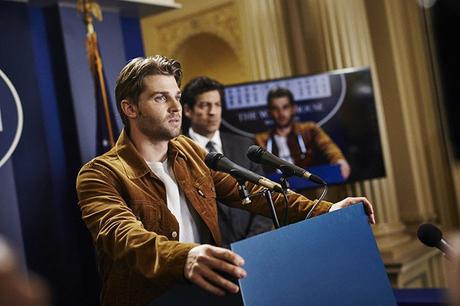At the start of its new three-night mini-series Childhood’s End, SyFy ran the following disclaimer: “In 1954, Arthur C. Clarke wrote a novel that influenced science fiction for decades to come. Tonight, that story comes to the screen for the first time.”
Is it really important to know that? Do you need to know that Childhood’s End is based on a classic Arthur C. Clarke (aka, the guy who co-wrote 2001: A Space Odyssey) novel? Not necessarily, but it helps in one crucial way: If you go into Childhood’s End fully aware that its source material is from the ’50s you might be a little more willing to forgive how much of it will remind you of classic sci-fi movies and TV shows which, for all you know, might have actually been influenced by the Clarke novel in the first place.
It’s the same problem the John Carter movie ran into a couple years ago. Well, actually, that movie had tons of issues (so many that someone wrote an entire book about it), but among them was the fact that its source material was exactly 100 years old. The original John Carter of Mars stories started in 1912, and exerted a huge influence over pop culture in the ensuing century. To cite a specific example, Superman’s initial ability to be able to leap tall buildings in a single bound was lifted straight out of John Carter, and in a more general sense Buck Rogers, Flash Gordon, Star Wars and even Avatar were rather candidly influenced by Carter. Can an actual John Carter movie be fairly accused of feeling derivative if the franchise has original ownership of many of the ideas and themes we now find to be overly familiar?
On a similar note, can the alien invasion story of Childhood’s End be knocked for doing a lot of things which probably felt unique, exciting and scary in 1954, but have now been thrown at us non-stop in new variations with different names? If it does those things really well, can it still be enjoyed?

You’ll be reminded of this
The basic plot of Part 1 (“The Overlords”) almost immediately recalls Independence Day. On an entirely normal 2016 day, gigantic, intimidating spaceships emerge from the clouds and hover above at least 40 of Earth’s principal cities, such as New York, London, Rio De Janeiro and Mumbai. The ID4 comparison jumped out at seemingly everyone live-tweeting their viewing experience, leading to many jokes like, “Is this Childhood’s End or the Independence Day: Resurgence trailer?” We meet our disparate group of main characters, all of whom appear to be scattered throughout America. There’s the handsome farmer in the heartland (Mike Vogel as Ricky), the disabled black kid in the projects (Osy Ikhile as Milo) and the opinionated member of the New York media who hates every part of this (Colm Meaney as Wainwright).

Colm Meaney as Wainwright, a role he could do in his sleep, with his assistant Ellie played by Daisy Betts
Here’s where it instantly differentiates itself from ID4: Instead of offering complete radio silence, this particular brand of alien appears to every person on Earth in the form of a deceased family member or loved one, using a familiar face to deliver a message of peace. Through these apparently psychically projected faces, the alien identifies itself as Karellen, the Supervisor of Earth. War, faminine, inequality, suffering and injustice will end. Karellen’s race thinks of themselves as enablers, not conquerors. Their goal is to achieve peace on Earth and herald the arrival of the golden age of man. The ships overhead are not there to invade but instead to police the Earth and stamp out pain and suffering, using constantly roaming sensors which broadly recall the toclafane from Doctor Who with a dash of Eva from Wall-E. Once the message is delivered, the familiar faces disappear leaving everyone understandably freaked out and entirely unsure how to communicate any further with Karellen.
We know this won’t work out because prior to the ID4 imagery with the space ships there was a brief prologue set sometime in the future where Earth looks like a wasteland and the adult version of Milo claims to be the last remaining human, begging one of Karellen’s sensors to remember us. If humanity is to end let us not be forgotten. What we don’t know is how exactly it doesn’t work out. Will this be like the Twilight Zone (a show which actually arrived 5 years after Clarke’s book) episode in which we shouldn’t trust any alien who arrives with promises of peace because they really just want to eat us? Or will this be more like The Simpsons “Treehouse of Horror” parody of that Twilight Zone episode where Lisa’s inability to trust robbed us all of world peace? Or will it be something somewhere in-between where the hidden cost for world peace will be so controversial as to inspire open and rather destructive rebellion among some of the humans?
That answer will play itself out in Parts 2 and 3 of the mini-series. After that killer opening, Part 1 is more concerned with charting the early rocky period of our relationship with Karellen, who remains unseen for almost the entirety of the two-hours. Instead, we hear Charles Dances’ distinctive voice communicating with Ricky, who is abducted and convinced to serve as the alien spokesperson. He is selected because he is a good, normal person with a strong local-level history of mediation, but he only agrees to do it because Karellen masterfully messes with his mind, playing on his unresolved trauma over a recent death in his life.

Ricky, not media-trained
Along the way, there are multiple knowing references to other shows and films in the alien invasion genre. Early on, Wainwright objects to naming the aliens “The Visitors,” going with “The Overlords” instead. Of course, there’s a famous mini-series (V) about aliens who arrive with promises of peace, and there they are called “The Visitors.” When scared farmers object to the presence of “The Overlords,” Ricky calms the situation by joking that it’s not exactly like one of the alien ships chopped off the head of The Statute of Liberty, which, of course, is one of the iconic images from ID4. Milo’s mom wonders aloud what the aliens’ weakness will be, pointing to Signs as an example of where that trope plays out. When Karellen first sends an autopiloted ship to collect Ricky, the impressively harrowing sequence recalls Close Encounters of the Third Kind and War of the Worlds. Ricky and his new fiance hide in the basement as the ship demateriallizes the house around them and unscrews the nails in the basement door.
You think you know where it’s going because you’ve seen this kind of thing before, but then it turns out Karellen just wants to talk to Ricky, with no harm intended (beyond psychological manipulation).
By the end of Part 1, you might be reminded of Torchwood: Children of Earth, The Day the Earth Stood Still or possibly other sci-fi artifacts (novels, films, tv shows) I’ve never heard of before. However, even if a lot of this felt familiar, it was never overly so. I could not tell for sure where this was going, and I’m betting that my assumptions about Part 2 are way off.
SyFy has made A LOT of noise about their efforts to launch a seemingly endless stream of scripted original programming, forever reaching for the next Battlestar Galactica and moving further away from being a network identified by its purposefully low-rent B-movies. Childhood’s End is at least their second effort at this in the mini-series arena after last year’s Ascension, and the money they put into this is readily apparent. Part 1 is only the beginning of the story meaning it’s too early to make any conclusions, but I’m hooked and, to be honest, I didn’t think I would be. What about you?

